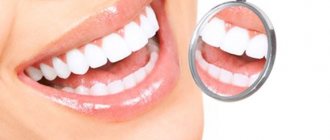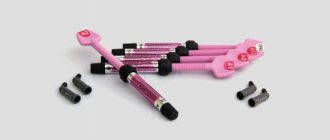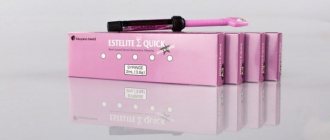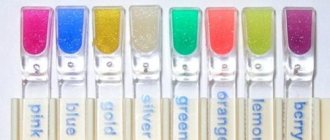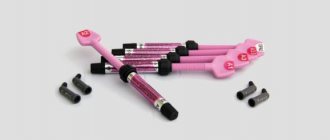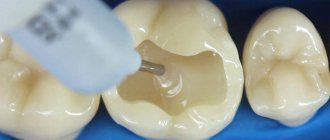Gutta-percha in dentistry
Gutta-percha is used as a natural material in many fields. The product has also found its application in dentistry.
Gutta-percha is a material obtained by processing the well-known latex, which is produced from the juice of the Gutta-percha plant. This product has high plastic properties, but at the same time is able to maintain a solid shape. The material acquires softness and pliability only under the influence of high temperatures, so canals are often filled with hot gutta-percha.
In dentistry, special gutta-percha is used to make pins, which, after treating the canals during endodontic treatment, are installed directly into the tooth canal. However, such a pin consists of only 20% gutta-percha (the upper part of the product), while the base is made of zinc oxide. In order for the treatment to be of high quality and, as a result of filling, each canal cavity is filled, gutta-percha pins of different sizes in length and width are produced.
Material characteristics
Gutta-percha structures are divided into the following types:
1. Conventional, manufactured in accordance with the dimensional standards for dental instruments accepted in Europe.
2. Non-standard, conical. They differ from standard solutions in their shorter length, larger width and pointed end.
Gutta-percha pins consist of the following components: – beta-gutta-percha, which occupies 1/5 of the entire product;
– zinc oxide, which plays the role of a framework;
– X-ray contrast compounds;
– antioxidants, pigmenting dyes.
The thickness of the structure corresponds to the color and number of the marking indicated on the packaging. The dentist, based on the clinical picture, selects the desired option.
Indications for filling
Gutta-percha is not a classic composite material, so it is used only for certain indications. Considering that the product is in the form of a pin, the dentist uses it only during endodontic treatment to fill and seal the dental canal.
Indications for filling root canals with hot gutta-percha:
- destruction of the dental crown more than 50%;
- saving only one root;
- curved dental root canals.
A gutta-percha point can be used to provide support for a single denture or crown. The product is not used if the destruction of the crown does not amount to more than half of its surface. This is explained by difficulties with installing the pin.
Installation: methods and features of filling
Various methods are used for filling. Hot involves introducing heated material into the channel to uniformly fill the cavity. Cold method - insertion of the rod without heating. However, this option is not the best; there is a possibility of infection and the development of periodontitis.
When filling, the following types of techniques are used:
- The use of one rod is practiced by doctors who have experience working with the paste. To avoid the formation of voids, a sealer is used for the work; a pin is first implanted into the canal, which is shortened to the required length.
- Lateral condensation. The root canal is dried and impregnated with sealer. Then a rod is inserted into the mouth and processed with a heated tool. This technique is complex and requires the doctor to have some experience.
- Injection thermomechanical method. With this option, gutta-percha is injected with a special syringe, but rehabilitation is long and there is a risk of infection, which does not make the method popular.
- Introduction of softened mass. The material is preheated and then introduced into the channel cavity. The advantage of this method is high-quality filling without voids.
The technique is of high quality, but the doctor must have experience. Otherwise, there are likely risks of tooth perforation and infection during filling.
Benefits of gutta percha
The peculiarity of gutta-percha is its composition. The product itself has a natural base, so it is absolutely safe for the body. The use of gutta-percha and zinc to make a pin is also considered an advantage of this filling method, since both materials have a high biocompatibility.
The advantages of filling dental canals with gutta-percha also include:
- complete sealing of the canals - due to the plasticity of the material, after heating it completely fills all cavities in the root canals, therefore eliminating the possibility of the filling falling out and the risk of infection getting inside;
- possibility of unsealing - in some cases it may be necessary to remove the pin; professional removal of all material will not cause difficulties for a specialist;
- interaction with medicinal substances - the filling material does not react with any drugs, as well as with the materials from which crowns are made;
- high strength - the gutta-percha pin does not deform, does not change color, does not oxidize and does not dissolve over time;
- visibility on x-rays - the base of the pin is made of zinc, so it is visible on x-rays;
Dentists prefer gutta-percha filling when treating canals, since this method is of higher quality, and during the filling process there are no difficulties with filling the canal voids or fixing the material.
Advantages and disadvantages
It is not for nothing that gutta-percha has been used in dentistry for many years. Among its advantages are the following:
- the material is flexible and elastic, therefore it fills the entire tooth cavity and seals the canals well;
- does not cause allergic reactions;
- preserves the tooth for a long time;
- clearly visible on x-ray;
- easy to unseal;
- affordable price.
The material also has disadvantages, although, compared to its advantages, they are much fewer. For example, gutta-percha does not have the ability to adhere to dentin and affect the microflora inside the tooth. Theoretically, this can lead to the development of caries and pulpitis, but the lack of these properties is compensated by other substances that dentists use during root canal filling.
The second disadvantage is that gutta-percha pins are too thin, and working with them requires great professionalism from the dentist. However, specialists often cope with this task successfully, and gutta-percha in dentistry remains the most popular material for these purposes, so there is clearly no need to be afraid of it.
The iOrtho clinic network provides high-quality services for correcting malocclusion with Invisalign aligners, sign up for a consultation now!
Filling process
Dental treatment when it is necessary to clean the canals always requires special professionalism of the dentist and the right approach to choosing treatment tactics. A qualified specialist will not resort to the procedure of installing a filling without first preparing the tooth.
Before filling the dental canals with gutta-percha, the entire cavity is treated using endomotors (special instruments). This method of cleaning the canals is considered to be of higher quality than laser or other procedures. After the channels are cleaned, they are dried with paper pins to eliminate the presence of saliva in the cavities.
The duration of treatment depends on the number of channels, the type of pathology and the characteristics of the cavities. On average, the procedure lasts 30–40 minutes.
Stages of gutta-percha filling:
- cleaning and drying the canals;
- installation of pins;
- softening gutta-percha using a special apparatus;
- condensation of gutta-percha in the upper part of the canal;
- supply of gutta-percha paste.
Filling the canals with material occurs in two stages, when the pin is softened and when additional heated gutta-percha paste is fed through the nozzle. In this way, it is possible to hermetically fill all channel voids.
Advantages and disadvantages
The advantages of using gutta-percha are:
- high indicators of material inertness, safety for the patient;
- the fit to the channel walls is high, compensation for shrinkage is observed;
- the material is stable, not subject to deformation or shrinkage;
- the degree of toxicity is low;
- hypoallergenic;
- When heated, the material softens and can be injected with a syringe.
Disadvantages include:
- with a narrow channel, difficulties arise in inserting the rod;
- when introducing, it is necessary to use sealed masses, since the material does not have high adhesion;
- control of administration is difficult;
- The material is neutral, that is, it cannot release active substances to tooth tissues.
Kinds
There are two types of endodontic gutta-percha products:
- Standard. The structures are manufactured in clearly defined sizes in accordance with European quality standards.
- Non-standard. They are distinguished by their atypical shape and taper. The products are wider and shorter than conventional pins and have a pointed end.
Compound
Components of gutta-percha points:
- beta-gutta-percha;
- zinc oxide;
- X-ray contrast connections;
- pigment dyes;
- antioxidants.
The product packaging indicates the thickness of the model, the number and color of the marking. The doctor selects the rod option according to clinical indications.
Stages of the procedure
The clinical protocol provides for a specific algorithm for filling with a gutta-percha pin:
- Identification and amputation of a fragment of dental tissue affected by caries.
- Pulp extraction from the root and coronal parts.
- Channel expansion.
- Antiseptic treatment of the working area.
- Screwing the sealer and rod into the passage cavity.
- Cutting off the top of the pin.
- Installation of temporary filling composite.
- Tooth filling.
Staging methods
There are two staging methods:
- Hot. The component is heated and injected into the root area. The liquid fills the cavity and prevents voids from forming. The technology is called the volumetric filling principle.
- Cold. Less popular. There is a risk of the rods not being fully screwed in and infection of the tooth root.
Methods for filling canals:
- Single rod option. Choosing dentists with experience in paste treatment. Minus - there is a guarantee of filling only the channel zone without branches. To prevent the formation of voids, a sealer is applied and a pin is implanted.
- Lateral condensation. The canal is dried, the walls are treated with paste, and the rod is implanted close to the walls of the cavity. The end of the pin is impregnated with sealer. Using additional rods, the remaining channel space is filled. The ends are trimmed and the material is pressed to condense. The technology is difficult to use.
- Thermomechanical injection. The technology is associated with the likelihood of complications during the rehabilitation process. Gutta-percha is administered using an injector. It is characterized by a long rehabilitation process and discomfort.
- Softening the component. It is carried out using the Thermafil system. During the heating process, the mass turns into a liquid that fills the channels and branches.
Potential Complications
The risk of complications is present during the work process and at the rehabilitation stage. The main reason for the development of complications is the inflammatory process that occurs as a result of poor-quality cavity filling with gutta-percha.
Repeating the procedure will correct the situation. Another danger is unintentional perforation. Pathology is detected when a dental instrument falls into the organ cavity. The affected area is covered with a cement mass and then sealed.
Adjusting the pin size
The root canals are first aligned and ground to the shape of the pin, and the pin itself is also adjusted as much as possible to the shape of the apical part of the patient’s canal, so that the canal has to be adjusted as little as possible. After preparing the canal, a visual selection of the size of the pin is carried out so that it tightly fills the apical part of the canal with a length of 3 or 4 mm. To do this, the pins are inserted one by one into the canal using tweezers or a clamp.
After visual and tactile selection of the pin, they ensure that it fits into the canal quite tightly (like a cork in the neck of a bottle). When this degree is reached, an X-ray of the inserted pin is taken and it is monitored that the pin completely fills the canal in the lower part. The formation of voids is unacceptable. If the pin goes beyond the apex, then it needs to be removed and shortened. The images are taken several times until the shape of the pin and the channel are completely matched.
Dentistry for those who love to smile
+7
Make an appointment

